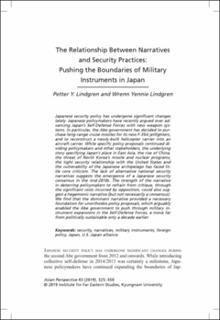| dc.contributor.author | Yennie Lindgren, Wrenn | |
| dc.contributor.author | Lindgren, Petter Y. | |
| dc.date.accessioned | 2022-06-24T06:51:33Z | |
| dc.date.available | 2022-06-24T06:51:33Z | |
| dc.date.created | 2019-04-12T01:57:51Z | |
| dc.date.issued | 2019 | |
| dc.identifier.citation | Asian Perspective. 2019, 43 (2), 325-350. | en_US |
| dc.identifier.issn | 0258-9184 | |
| dc.identifier.uri | https://hdl.handle.net/11250/3000458 | |
| dc.description.abstract | Japanese security policy has undergone significant changes lately. Japanese policymakers have recently argued over advancing Japan’s Self-Defense Forces with new weapon systems. In particular, the Abe government has decided to pur- chase long-range cruise missiles for its new F-35A jetfighters, and to reconstruct a newly-built helicopter carrier into an aircraft carrier. While specific policy proposals continued di- viding policymakers and other stakeholders, the underlying story specifying Japan’s place in East Asia, the rise of China, the threat of North Korea’s missile and nuclear programs, the tight security relationship with the United States and the vulnerability of the Japanese archipelago has faced lit- tle core criticism. The lack of alternative national security narratives suggests the emergence of a Japanese security consensus in the mid-2010s. The strength of the narrative in deterring policymakers to refrain from critique, through the significant costs incurred by opposition, could also sug- gest a hegemonic narrative (but not necessarily a consensus). We find that the dominant narrative provided a necessary foundation for unorthodox policy proposals, which arguably enabled the Abe government to push through military in- strument expansions in the Self-Defense Forces, a move far from politically sustainable only a decade earlier. | |
| dc.language.iso | eng | en_US |
| dc.rights | Navngivelse 4.0 Internasjonal | * |
| dc.rights.uri | http://creativecommons.org/licenses/by/4.0/deed.no | * |
| dc.title | The Relationship Between Narratives and Security Practices: Pushing the Boundaries of Military Instruments in Japan | en_US |
| dc.type | Journal article | en_US |
| dc.type | Peer reviewed | en_US |
| dc.description.version | acceptedVersion | |
| dc.source.pagenumber | 325-350 | en_US |
| dc.source.volume | 43 | en_US |
| dc.source.journal | Asian Perspective | en_US |
| dc.source.issue | 2 | en_US |
| dc.identifier.cristin | 1691838 | |
| dc.relation.project | Norges forskningsråd: 250419 | |
| cristin.unitcode | 7471,11,0,0 | |
| cristin.unitname | Russland, Eurasia og internasjonal handel | |
| cristin.ispublished | true | |
| cristin.fulltext | postprint | |
| cristin.qualitycode | 1 | |

